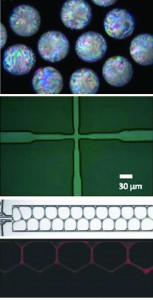
From top to bottom: Cholesteric particles formed via microfluidics. Flow-focusing microfluidic device. Gel emulsion in a channel. Fluorescence image of a dye-containing gel emulsion.
This week I attended a talk at the MPI for Dynamics and Self-Organisation in Goettingen, Germany by Nicolas Bremond from the EPSCI, Paris. The talk was titled “Microfluidic investigations of the destabilisation of emulsions via coalescence”. Nicolas discussed the use of microfluidic devices to study coalescence of emulsion droplets in the absence and presence of an ac electric field. The results have been published in Physical Review Letters and in the Journal of Fluid Mechanics.
In the absence of an electric field, a series of moving pairs of droplets in a microfluidic device were created. A widening of the channel, and therefore slowing of the fluid, was used to force the droplets together. Monitoring of the separation of the droplets showed that coalescence occurred just after closest proximity i.e. when they were separating. Nicolas believes that the separation of the droplets momentarily reduces the fluid pressure between the droplets, causing the high-pressure water in the droplets to burst through the barrier.
Amongst many of the movies shown in the talk was this one, which I have found on the web. It shows that this coalescence mechanism can also trigger coalescence in neighbouring droplets. This mechanism could perhaps be responsible for the clumping of industrial emulsion droplets.
My favourite video of the talk was one showing the behaviour of the emulsion droplets under an applied ac electric field. When the ratio of the radius of the droplet to the channel width is equal to 0.8 the droplets can be made to kiss each other; they come into contact with each other before separating again. On separation deformation of the droplets is observed. Unfortunately I haven’t found a video of this online, but a sequence of images can be seen in the Physical Review Letters paper.
Although not mentioned in the talk, Nicolas has also recently had his paper Formation of liquid-core capsules having a thin hydrogel membrane: liquid pearls published in Soft Matter.
Microfluidics offers an interesting method for studying the coalescence of emulsions under flow. However, this is not its only application as seen in the latest issue and advance articles of Soft Matter. Shashi Thutupalli et al. (doi:10.1039/c0sm00312c) demonstrate the use of microfluidics to self-assemble surfactant bilayer networks in water-oil emulsions. These bilayer membranes display a range of different electrical behaviours, which could be exploited to create wet circuitry. Formation of emulsions in this way, offers a feasible approach to construct complex devices out of molecular-sized components via controlled self-assembly.
Sara Abalde-Cela et al. demonstrate the use of a flow-focusing microfluidic device to form highly mono-disperse plasmonic agarose beads containing silver nanoparticles in their paper doi:10.1039/c0sm00601g, while Daniel Wenzlik et al. used microfluidics to prepare cholesteric liquid crystal particles from cellulose derivatives doi:10.1039/c0sm01368d.










